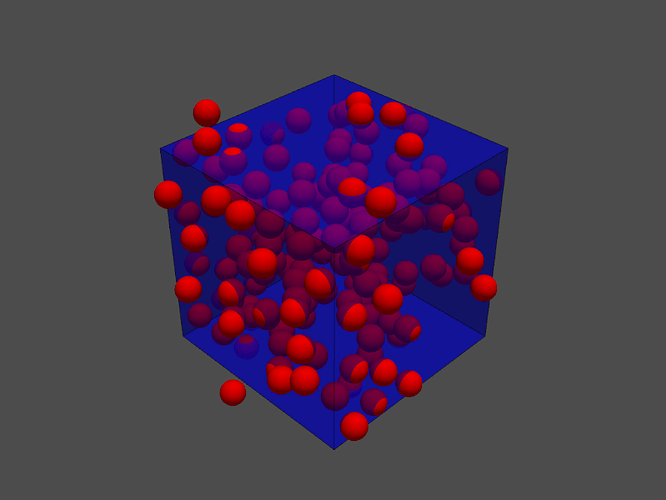Hi,
I am trying to mesh a unit cube containing several randomly distributed spherical inclusions. Since the cube is triply periodic (along x, y and z) I create matching spheres on the faces/edges to be able to generate a mesh with matching pairs of vertices.
I am currently running two cases:
-
Not including the spheres (basically meshing
cube - all_spheresobject). This runs fine and produces a matching mesh as desired. -
Including the spheres. In this case I get the error, " Stop meshing since boundary mesh is overlapping ". I am assuming that it could arise from the spheres on two faces not being exactly mirrored. But then why would case 1. run perfectly fine? Any suggestions?
I am attaching the portion of the code that generates the mesh
def generateGmshMesh(xc, pc, rc):
"""
docstring
"""
left = Plane(Pnt(0,0,0),Vec(-1,0,0))
bottom = Plane(Pnt(0,0,0),Vec(0,-1,0))
back = Plane(Pnt(0,0,0),Vec(0,0,-1))
right = Plane(Pnt(1,0,0),Vec(1,0,0))
top = Plane(Pnt(0,1,0),Vec(0,1,0))
front = Plane(Pnt(0,0,1),Vec(0,0,1))
cube = left * right * bottom * top * back * front
all_spheres = [Sphere(Pnt(sph[0], sph[1], sph[2]), rc[i]) for i, sph in enumerate(xc)]
all_particles = [Sphere(Pnt(sph[0], sph[1], sph[2]), rc[i]) for i, sph in enumerate(pc)]
for i, sph in enumerate(all_spheres):
if i==0:
sphAll = all_spheres[i]
else:
sphAll += all_spheres[i]
for i, sph in enumerate(all_particles):
if i==0:
partAll = all_particles[i]
else:
partAll += all_particles[i]
# reduce(operator.mul, all_spheres)
# partAll = reduce(operator.mul, all_particles, 1)
matrix = cube - sphAll
partsinCube = cube * partAll
matrix.maxh(0.01)
partsinCube.maxh(0.005)
matrix.transp()
partsinCube.col([1,0,0])
matrix.mat("mat")
partsinCube.mat("parts")
geo = CSGeometry()
geo.Add(matrix)
geo.Add(partsinCube)
geo.PeriodicSurfaces(left,right)
geo.PeriodicSurfaces(bottom,top)
geo.PeriodicSurfaces(back,front)
geo.Draw()
Redraw()
msh = geo.GenerateMesh()
msh.Export("trialMesh.msh", "Gmsh2 Format")
msh.Export("trialMesh.inp", "Abaqus Format")I tried playing with the maxh paramter but to no avail.
